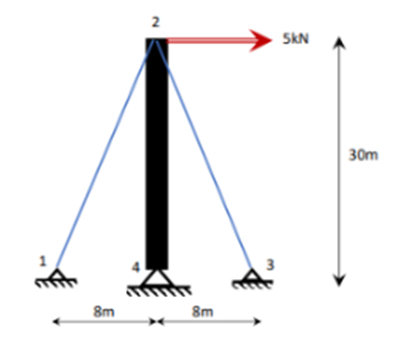c) A telecommunication tower shown in Fig Q1-1 consists of the main structural element 2-4 and cables in elements 1-2 and 2-3. The main structural element can resist both tension and compression while the cables can only resist tensile forces. i) Using the matrix implementation of the stiffness method, compute the deflection at Node 2 induced by the lateral load shown. Compute the member forces ii) Assume E-200GPa and Area of main structural element - 40 x 10³ mm². Area of cables - 40 x 10² mm² Hint: All calculations should be based on the given node numbering in the figure.
c) A telecommunication tower shown in Fig Q1-1 consists of the main structural element 2-4 and cables in elements 1-2 and 2-3. The main structural element can resist both tension and compression while the cables can only resist tensile forces. i) Using the matrix implementation of the stiffness method, compute the deflection at Node 2 induced by the lateral load shown. Compute the member forces ii) Assume E-200GPa and Area of main structural element - 40 x 10³ mm². Area of cables - 40 x 10² mm² Hint: All calculations should be based on the given node numbering in the figure.
Chapter2: Loads On Structures
Section: Chapter Questions
Problem 1P
Related questions
Question
1 c)

Transcribed Image Text:a) List and briefly explain 3 differences between stiffness and flexibility methods of structural
analysis.
b) State two advantages that the stiffness method has over flexibility methods.
c) A telecommunication tower shown in Fig Q1-1 consists of the main structural element 2-4 and
cables in elements 1-2 and 2-3. The main structural element can resist both tension and
compression while the cables can only resist tensile forces.
i)
Using the matrix implementation of the stiffness method, compute the deflection at Node
2 induced by the lateral load shown.
ii)
Compute the member forces
Assume E = 200GPa and Area of main structural element = 40 x 10³ mm².
Area of cables - 40 x 10² mm²
Hint: All calculations should be based on the given node numbering in the figure.
Fig Q1-1
1
8m
4
2
5kN
30m
XE
3
8m
Expert Solution
Step 1: Introduce the problem statement



Step by step
Solved in 11 steps with 24 images

Knowledge Booster
Learn more about
Need a deep-dive on the concept behind this application? Look no further. Learn more about this topic, civil-engineering and related others by exploring similar questions and additional content below.Recommended textbooks for you


Structural Analysis (10th Edition)
Civil Engineering
ISBN:
9780134610672
Author:
Russell C. Hibbeler
Publisher:
PEARSON

Principles of Foundation Engineering (MindTap Cou…
Civil Engineering
ISBN:
9781337705028
Author:
Braja M. Das, Nagaratnam Sivakugan
Publisher:
Cengage Learning


Structural Analysis (10th Edition)
Civil Engineering
ISBN:
9780134610672
Author:
Russell C. Hibbeler
Publisher:
PEARSON

Principles of Foundation Engineering (MindTap Cou…
Civil Engineering
ISBN:
9781337705028
Author:
Braja M. Das, Nagaratnam Sivakugan
Publisher:
Cengage Learning

Fundamentals of Structural Analysis
Civil Engineering
ISBN:
9780073398006
Author:
Kenneth M. Leet Emeritus, Chia-Ming Uang, Joel Lanning
Publisher:
McGraw-Hill Education


Traffic and Highway Engineering
Civil Engineering
ISBN:
9781305156241
Author:
Garber, Nicholas J.
Publisher:
Cengage Learning